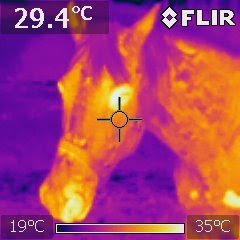The following is directly from the Ontario Ministry of Agriculture Food & Rural Affairs Ontario.
Lives have been lost and hay crops destroyed because of fires caused by spontaneous combustion. This year has been particularly bad for hay heating due to the hot humid weather. If the hay crop is put into the mow above 20-25% moisture content, spontaneous combustion may occur.
A hay crop that is placed too wet into a mow will heat rapidly. If the mow is so large that heat loss is restricted, the internal temperature will rise. As the temperature rises above 130°F (55°C), a chemical reaction occurs and may sustain itself. This reaction does not require oxygen, but the flammable gases produced are at a temperature above their ignition point. These gases will ignite when they come in contact with the air.
Check your hay regularly. If you detect a slight caramel odour or a distinct musty smell, chances are your hay is heating.
What do you do if you suspect that your hay is heating? First of all, make yourself a simple probe that can be inserted into the hay mass to check the temperature. A probe can be made from a 10 foot piece of electrical tubing. Rivet a hardwood pointed dowel to one end and drill 8 - 3/16 inch diameter holes in the tube just above the dowel. Drive the probe into the hay mass and lower a candy thermometer on a long string into the probe. The thermometer should be left for 10 minutes to ensure an accurate reading.
Watch for the following temperatures:
150°F (65°C) ** Entering the Danger Zone. Check temperature daily.
160°F (70°C) ** Danger! Measure temperature every four hours and inspect mow.
175°F (80°C) ** Call the Fire Department! Wet hay down and remove from the barn.
185°F (85°C) ** Hot Spots and Pockets May be Expected. Flames will likely develop when heating hay comes in contact with the air.
212°F (100°C) Critical! Temperature rise is rapid above this point. Hay will almost certainly ignite.
Caution: Before entering the mow, place long planks on top of the hay. Do not attempt to walk on the hay mass itself. Pockets may have already burned out under the hay surface. Always tie a rope around your waist and have a second person on the other end in a safe location to pull you out should the surface of the hay collapse into a fire pocket.
Extreme caution should be taken when fighting a hay fire if hay has been treated with chemical preservatives. Hay treated with preservatives containing ethoxyquin and BHT (butylated hydroxytoluene) will produce hydrogen cyanide gas at around 240°F (115°C). This gas is very deadly. Additives containing primarily propionic acid to not produce hydrogen cyanide during a fire.
Many farmers sprinkle salt on hay as it is stored, in an effort to prevent hay fires. However, tests have shown that salt has no effect on controlling spontaneous combustion. Dry ice, liquid nitrogen or carbon dioxide gas pumped into the hay will prevent combustion by eliminating the oxygen from the hay mass.
Spontaneous combustion is not an accident. By following good storage practices, not only will spontaneous combustion by avoided, but a higher quality of hay will be obtained.
Thermal Imaging can be utilized to assist in detecting spontaneous combustion temperatures before they become critical.
There are some limitations, as Infrared imaging cannot see within an object; only the infrared radiation measured at the surface. This, however, can be extremely valuable when taking measuerments with a probe. Infrared images of the hay storage can be gathered, from there a decision can be made on where to probe for the HIGHEST temperature possible.
Temperatures within oraganic materials vary greatly, untill now only an educated guess or blind probing would lead to the highest measured temperatures. With the use of infrared, another level of measurement is available; and a targeted strike can be carried out on the danger zones.
skip to main |
skip to sidebar
Pages
About Us...
Based in Ontario, Canada Advanced Energy Solutions provides professional Thermography (Infrared Imaging or Thermal Imaging). The images capture what human eyes cannot see. We offer a range of services covering a wide range of applications. See Our Introduction page for more information.
See what Thermography is all about; check out our promotional video here
No other method of non-destructive testing reveals what Thermography can.
See what Thermography is all about; check out our promotional video here
No other method of non-destructive testing reveals what Thermography can.
Site Archive- Click month to expand
Facebook Fan Box
Advanced Energy Solutions on Facebook
Search This Site
Site Topics- Click to View
- Acoustic Diagnostics (1)
- Advanced Energy Solutions (3)
- Air Intrusion (2)
- Airborne Ultrasound (1)
- Bathroom (1)
- Breakers (1)
- Business Inspection (2)
- Drafts (2)
- Electrical (2)
- Emissivity (1)
- Energy Loss (2)
- Equine Imaging (1)
- FLIR (4)
- FLIR i7 (1)
- Goderich Ontario (1)
- Hay Sorage (1)
- Home Imaging (4)
- Home Inspection (4)
- Horse Imaging (1)
- Industrial (3)
- Infrared (12)
- Infrared Camera (2)
- Mildew (1)
- Moisture Detector (1)
- Moisture Intrusion (2)
- Mould (2)
- Mould Inspection (2)
- Save Money (2)
- Spontaneous Combustion (1)
- Thermal Camera (3)
- Thermal Dynamics (6)
- Thermal Imaging (9)
- Thermography (7)
- Water Intrusion (3)
Copyright © 2009 - 2010 Advanced Energy Solutions . All Rights Reserved. Please read our website disclaimer







